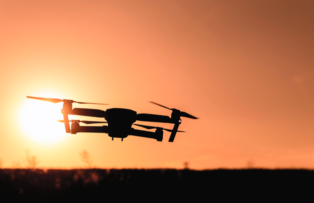By Amy French, AUVSI Freelance Editor
Challenges with pricing may be slowing their spread, but drones have become an increasingly pervasive component of telecom tower inspections since AT&T began using the technology just a few years ago.
“We do thousands of tower inspections with drones every year now,” said Art Pregler, head of AT&T’s drone program, which launched in 2015. “They have been adopted, accepted, and they are now part of business as usual.”
AT&T gave drones in telecom a drumroll in 2016 when it completed tower-inspection trials with DJI’s Aspire 1 and hailed wins in terms of greater accuracy and efficiency, less environmental disruption and – most importantly – safety.
Cell towers typically run from 60 feet to 350 feet tall, and broadcast towers can be up to 2,000 feet. Manual climbs are notoriously dangerous.
Drones loaded with imaging equipment can eliminate the need for some climbs, as well as provide a way to check towers before climbs that are necessary, noted Chris Mallon, chairman of the NATE’s UAS Committee. For those reasons, he said, NATE favors the technology and is working to craft industrywide protocols for its use.
However, Mallon said, drones aren’t catching on as quickly as NATE would like.
“I think it will evolve, but it’s not evolving as fast as people thought it would, and that is mostly because of resistance by the tower owners, basically, because the drone people tend to be charging more,” he said. “They’re like, ‘Why should I pay $2,000 for a drone when I can pay $1,500 for the guys to climb?’”
Pregler agreed that tower owners and maintenance crews sometimes see drones as an unnecessary expense, given that climbers can perform inspections, including hands-on tasks, and drones can’t perform repairs. Price disparities grow, he noted, if a tower crew doesn’t include a drone operator and would have to call one in.
“The challenge with adoption is the very competitive cost of doing it the traditional way with tower climbers,” Pregler said, adding that AT&T generally lets contractors decide whether to use drones for inspections. “If we’re looking for rust and connectors that are not right, that’s great for a visual-only inspection. But if we need to torque a bolt … right now, the drones don’t do that.”
What drones can do, however, has expanded dramatically since 2016, and advances are likely to continue. For example, DJI spokesman Michael Oldenburg noted, the company’s Matrice line has capabilities well beyond those of the Inspire from AT&T’s trials – and beyond what humans can do.
For starters, drones with RTK (Real Time Kinematic) technology can fly closer to towers without electromagnetic signals disrupting on-board compasses. Other advances include the ability to carry two cameras – making it possible in one trip to capture, say, a zoomed-in photo of a serial number, as well as thermal images of a tower. Using photogrammetry, it’s possible to translate multiple photos into a 3-D model, or digital twin, of a tower for precise examination. And advances in automation enable more complex sequences of tasks to be programmed in advance, leaving less room for human error during a flight.
Such advances heighten precision, which translates to clearer communication for tower users, Pregler noted, but they don’t necessarily bring down costs.
“There are still advantages to the manual approach, and there are advantages to using drones,” he said. “I wouldn’t say drones are replacing human inspectors; I’d say they’re augmenting them. And we’re doing that where it makes sense.”
XPONENTIAL 2020
As the world’s largest, most comprehensive event for the unmanned systems industry, AUVSI XPONENTIAL 2020 will give attendees the opportunity to find their edge and their inspiration. Join AUVSI in Boston this May 4-7 to explore the latest technology innovations in air, ground and maritime, develop new perspectives while hearing from industry influencers and experts, and cultivate creativity at special networking events that offer opportunities to meet and converse with some of the most influential leaders in the unmanned and autonomous community.
Featuring an exhibit hall with more than 700 exhibitors and special features, XPONENTIAL 2020 is the global stage for everything unmanned and creates unique new experiences that extract the most value possible for attendees. Register at xponential.org to join more than 8,500 users, technologists and policymakers as they collaborate to push the unmanned systems industry forward, share lessons learned and build new partnerships to define the future of all things unmanned.





Reader Interactions